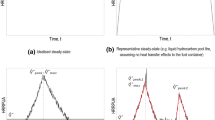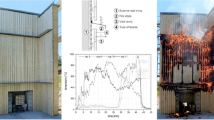Abstract
The aim of this paper is to analyse the application of the Peatross–Beyler (P&B) correlation (Fire and safety science—Proceedings of the fifth international symposium, 1997) to calculate the Mass loss rate (MLR) for a pool fire in a confined and ventilated enclosure for a range of conditions. The experimental references considered are the PRISME-SI-D1, D2 and D6 tests (Prétrel et al. in 9th International seminar on fire safety in nuclear power plants and installations, 2005), conducted by the Institut de Radioprotection et de Sûreté Nucléaire. The dimensions of the enclosure used in the experiment are 5 m in length, 6 m in width and 4 m in height. A pool fire, \(0.4\,\hbox {m}^2\) hydrogenated tetrapropylene (TPH, \(\hbox {C}_{12}\hbox {H}_{26}\)), is located in the center of the room. The compartment is connected to the outside through an inlet and outlet. The P&B correlation is implemented as a boundary condition in computational fluid dynamics calculations. The MLR outcome depends on the average \(\hbox {O}_2\) concentration in a predefined volume and the characteristics of the fuel. The influence of the size and location of the predefined volume, the ventilation branch position (at 1 m and 3.65 m from the floor) and the Renewal Rate (\(R_r\)) (\(4.7\,\hbox {h}^{-1}\) and \(8.4\,\hbox {h}^{-1}\)) are studied. Two types of \(\hbox {O}_2\) predefined volumes have been tested: layer and ring. The layer volume is located in the low part of the compartment, the base of the volume spanning the compartment floor. The ring is a volume around the pit. It is assumed for both approaches that the measured \(\hbox {O}_2\) is representative of the available oxygen for the flame. The P&B boundary condition predicts the influence of the vitiation on the MLR. Other methods, such as imposing the MLR expected in open condition, overpredict the amount of injected fuel. The results show that the P&B correlation provides good agreement with the experimental data. The deviation between experimental data and numerical prediction for the average MLR in the best case is −5.0% with absolute values of 0.004 kg/s and 0.0038 kg/s for the experiment and the simulation respectively for case PRS-SI-D1. The MLR calculation is influenced by the position of the ventilation opening and the \(R_r\). The temperature and \(\hbox {O}_2\) concentration profiles are significantly influenced by the ventilation configuration. These differences are related to the transport of the injected air from the inlet to the floor by density difference.


















Similar content being viewed by others
Notes
The CFD code ISIS can be freely downloaded from the following website: https://gforge.irsn.fr/gf/project/isis/.
Abbreviations
- \(D\) :
-
Pool fire diameter (m)
- \(f\) :
-
Friction coefficient (Pa)
- \({ GER}\) :
-
Global Equivalence Ratio
- \(k \beta \) :
-
Empirical extinction constant (\(\hbox {m}^{-1} \))
- \({{\dot{m}}^{''}} \) :
-
Mass loss rate per unit area (kg/s \(\hbox {m}^2\))
- \( \dot{m}_{\infty }^{''} \) :
-
Maximum MLR per unit area (\(\hbox {kg/s}\,\hbox {m}^2 \))
- \({{\dot{m}^{''}_{open}}} \) :
-
Mass loss rate per unit area in open conditions (\(\hbox {kg/m}^2\,\hbox {s}\))
- \(\dot{m}^{0}_{v} \) :
-
Air mass flow rate (kg/s)
- \({ MLR}\) :
-
Mass loss rate (kg/s)
- \(\hbox {O}_2{[}\%{]} \) :
-
Oxygen concentration (vol%)
- \( P \) :
-
Pressure inside the compartment (Pa)
- \( P_{ext} \) :
-
External pressure at the end of the ventilation branch (Pa)
- \(r\) :
-
Stoichiometric ratio
- \(R\) :
-
Aeraulic resistance (\(\hbox {m}^{-4}\))
- \(R_r\) :
-
Renewal Rate (\(\hbox {h}^{-1} \))
- \(X_{\mathrm{O}_2}\) :
-
Oxygen molar fraction in a “reference volume”
- \({ VFR}\) :
-
Volume flow rate (\(\hbox {m}^{3}/\hbox {s}\))
References
Peatross MJ, Beyler CL (1997) Ventilation effects on compartment fire characterization. In: Fire and safety science—proceedings of the fifth international symposium, pp 403–414
Prétrel H, Le Saux W, Such JM (2005) Experimental study of the burning rate behaviour of pool fires in confined and ventilated compartments. In: Post-conference seminar III of the 18th international conference on structural mechanics in reactor technology (SMIRT 18). 9th International seminar on fire safety in nuclear power plants and installations
Merci B, Beji T (2016) Fluid mechanics aspects of fire and smoke dynamics in enclosures. CRC Press, London
Drysdale D (2003) An introduction to fire dynamics. Wiley, Chichester, pp 325–370
Backosvky J, Foote KL, Alvares NJ (1989) Temperature profiles in forced-ventilation enclosures fires. In: Fire and safety science—proceedings of the second international symposium, pp 315–324
Beyler C (1991) Analysis of compartment fires with overhead forced ventilation. In: Fire and safety science-proceedings of the third international symposium, pp 291–300
Prétrel H, Suard S, Audouin L (2016) Experimental and numerical study of low frequency oscillatory behaviour of a large-scale hydrocarbon pool fire in mechanically ventilated compartment. Fire Saf J 83:38–53
Prétrel H, Koched A, Audouin L (2016) Doorway flows induced by the combined effects of natural and forced ventilation in case of multi-compartments large-scale fire experiments. Fire Technol 52:489–514
Zhang B, Wang X, Lu S, Li C, Chen R, Zhang J, Wang X (2016) Effect of air inlet configuration on forced-ventilation enclosure fires on a naval ship. Fire Technol 52:547–562
Sikanen T, Hostikka S (2016) Modeling and simulation of liquid pool fires with in-depth radiation absorption and heat transfer. Fire Saf J 80:95–105
Peatross MJ, Beyler CL, Back GG (1993) Validation of full room involvement tire correlation applicable to steel ship compartments, ADA284096
Santo G, Tamanini F (1981) Influence of oxygen depletion on the radiative properties of PMMA flames. In: Eighteenth symposium (international) on combustion. The Combustion Institute
Tewarson A, Lee JL, Pion F (1981) The influence of oxygen concentration on fuel parameters for fire modelling. In: Eighteenth symposium (international) on combustion. The Combustion Institute
Bonte F, Noteman N, Merci B (2013) Computer simulations to study interaction between burning rates and pressure variations in confined enclosure fires. Fire Saf J 63:125–143
Suard S, Forestier M, Vaux S (2013) Toward predictive simulations of pool fires in mechanically ventilated compartments. Fire Saf J 61:54–64
Suard S, Lapuerta C, Babik F, Rigollet L (2013) Verification and validation of a CFD model simulations of large-scale compartment fires. Fire Saf J 61:54–64
Suard S, Koched A, Prétrel H, Audouin L (2015) Numerical simulations of fire-induced doorway flows in a small scale enclosure. Int J Heat Mass Transf 81:578–590
Suard S, Nasr A, Melis S, Garo JP, El-Rabii H, Gay L, Rigollet L, Audouin L (2011) Analytical approach for predicting effects of vitiated air on the mass loss rate of large pool fire in confined compartments. In: Fire-safety science—proceedings of the tenth international symposium, pp 1513–1524
Audouin L, Rigollet L, Prétrel H, Le Saux W, Röwekamp M (2013) OECD PRISME project: Fires in confined and ventilated nuclear-type multi-compartments-Overview and main experimental results. Fire Saf J 62:80–101
Mizukami T, Utiskul Y, Quintiere JG (2016) A compartment burning rate algorithm for a zone model. Fire Saf J 79:57–68
ISO 5660-1:2015 (2015) Reaction-to-fire tests—heat release, smoke production and mass loss rate-Part1: heat release rate (cone calorimeter method) and smoke production rate (dynamic measurement), p 2
Floyd JE, Mcgrattan KB (2009) Extending the mixture fraction concept to address underventilated fires. Fire Saf J 44:291–300
Poinsot T, Veynante D (2005) Theoretial and numerical combustion. Edwards, Philadelphia, pp 84–88
Magnussen BF, Hjertager BH (1976) On mathematical modeling of turbulent combustion with special emphasis on soot formation and combustion. In: Sixteenth symposium (international) on combustion, pp 719–729. The Combustion Institute
Versteeg HK, Malalasekera W (2007) An introduction to computation fluid dynamics. The finite volume method. Prentice Hall, London, pp 135–168
Beji T, Merci B (2016) Blind simulation of periodic pressure and burning rate instabilities in the event of a pool fire in a confined and mechanically ventilated compartment. Combust Sci Technol 188(4–5):504–515
Malalasekera WMG, Versteeg HK, Gilchrist K (1996) A review of research and a experimental study on the pulsation of buoyancy diffusion flames and a pool fires. Fire Mater 20:261–271
Backovsky J, Foote KL, Alvares NJ (1989) Temperatures profiles in forced-ventilation enclosure fires. In: Fire and safety science—proceedings of the second international symposium, pp 315–324
Williamson J, Beyler C, Floyd J (2011) Validation of numerical simulations of compartment fires with forced or natural ventilation using the fire and smoke simulator (FSSIM), CFAST and FDS. In: Fire and safety science—proceedings of the tenth international symposium, pp 1277–1288
Acknowledgements
J. Felipe Perez Segovia is a PhD Student funded by Bel V (Belgium). Tarek Beji is a Posdoctoral Fellow of the Fund for Scientific Research-Flanders (Belgium) (FWO Vlaanderen). The authors are grateful for the technical support provided by S. Suard, H. Prétrel, F. Babik and L. Audouin from IRSN.
Author information
Authors and Affiliations
Corresponding author
Rights and permissions
About this article
Cite this article
Perez Segovia, J.F., Beji, T. & Merci, B. CFD Simulations of Pool Fires in a Confined and Ventilated Enclosure Using the Peatross–Beyler Correlation to Calculate the Mass Loss Rate. Fire Technol 53, 1669–1703 (2017). https://doi.org/10.1007/s10694-017-0654-2
Received:
Accepted:
Published:
Issue Date:
DOI: https://doi.org/10.1007/s10694-017-0654-2




